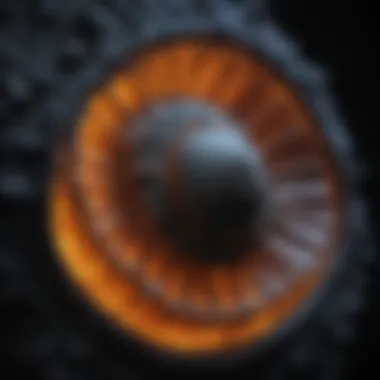Unveiling the Advantages of Black Light Cleaning for Collectors: An In-Depth Exploration


Rock and Fossil Identification
In the world of rock and fossil collecting, identifying different types of specimens is fundamental. Rocks can range from sedimentary to igneous to metamorphic, each with distinct characteristics to look for. Sedimentary rocks like sandstone often exhibit layering or grainy textures, while igneous rocks such as granite display interlocking crystal patterns. Metamorphic rocks like marble may reveal swirls and foliation. Fossils, on the other hand, can be identified based on their imprint, bone structure, or even trace fossils like footprints. Utilizing tools such as magnifying lenses, UV lights, and hardness testers can aid collectors in accurate identification.
Collecting Tips and Techniques
When venturing into collecting rocks and fossils, employing best practices is crucial for a successful endeavor. Locating prime collecting sites involves research to pinpoint areas abundant in geological treasures. Once on-site, safely extracting specimens without causing damage requires careful tools like chisels, hammers, and brushes. Ensuring that specimens are ethically collected and adhering to landowners' guidelines are paramount in preserving sites for future collectors.
Preservation and Display
Preserving rocks and fossils is a delicate process that requires specific techniques to maintain their integrity. Proper storage methods include using acid-free paper, padded specimen boxes, and storing in a cool, dry place to prevent deterioration. Creative display ideas can include mounting specimens on stands or arranging them in themed collections to showcase their beauty and educational value.
Geological Insights
Delving into geological insights offers collectors a deeper understanding of the history and formation of rocks and fossils. Studying geological formations and processes can unveil the conditions under which specimens were created, enriching collectors' appreciation. Exploring the historical significance and notable discoveries in the field can provide context to collected specimens and spark further curiosity in the intricate world of geology.
Introduction
In this comprehensive guide titled [Exploring the Benefits of Black Light Cleaning for Collectors], we delve into the intriguing world of black light cleaning, a specialized technique that holds immense value for collectors of rocks and fossils. This article aims to provide a detailed and informative overview of how black light cleaning can bring a new dimension to collection maintenance practices. By exploring the origins, intricacies, and benefits of this technique, readers will gain valuable insights into optimizing the cleanliness and aesthetic appeal of their precious specimens.
Understanding Black Light Cleaning
History of Black Light Cleaning
Black light cleaning has a rich history that dates back to its emergence as a revolutionary method for illuminating and enhancing the beauty of various collectibles, particularly rocks and fossils. The evolution of black light cleaning showcases its profound impact on collectors worldwide, revolutionizing the way they interact with and showcase their prized possessions. This historical background serves as a fundamental pillar in understanding the significance and relevance of incorporating black light cleaning into contemporary collection maintenance practices, making it a preferred choice for collectors seeking to elevate the visual appeal and authenticity of their specimens.
Purpose and Benefits
The primary aim of black light cleaning is to reveal hidden features, enhance fluorescence, and uncover the true brilliance of rocks and fossils. By harnessing the unique properties of ultraviolet (UV) light, collectors can unlock a world of hidden details and colors that may not be visible under standard lighting conditions. The benefits of black light cleaning extend beyond aesthetics, offering collectors the opportunity to identify minerals, authenticate specimens, and preserve the integrity of their collections for years to come. This section delves into the specific advantages of utilizing black light cleaning within the realm of rock and fossil collection maintenance, shedding light on its transformative effects and practical applications.
Tools and Equipment
UV Black Light
A crucial component of the black light cleaning process, the UV black light plays a pivotal role in illuminating specimens and highlighting their unique attributes. Its ability to reveal fluorescence and detect hidden features makes it an essential tool for collectors looking to enhance the visual appeal of their rocks and fossils. Understanding the different types of UV black lights, their intensity levels, and optimal usage conditions is key to maximizing the benefits of this specialized cleaning technique.
Protective Gear
As with any cleaning process involving UV light exposure, protective gear is essential to ensure the safety and well-being of collectors. From UV-blocking goggles to barrier creams, the right protective equipment can prevent potential risks associated with prolonged exposure to ultraviolet light. This section discusses the importance of protective gear in Black light cleaning activities and highlights the necessary precautions that collectors must take to safeguard their health and maintain a secure cleaning environment.
Setting Up the Cleaning Space


Optimal Conditions
Creating the ideal cleaning space is a critical aspect of the black light cleaning process, as it directly impacts the effectiveness and efficiency of the procedure. Factors such as room temperature, lighting conditions, and cleanliness play a significant role in maintaining a conducive environment for inspecting and cleaning specimens under UV light. By optimizing the conditions within the cleaning space, collectors can ensure thorough and meticulous examination of their rocks and fossils, enhancing the overall experience and results of the cleaning process.
Safety Measures
Prioritizing safety measures is paramount when setting up a cleaning space for black light cleaning activities. Implementing safety protocols, such as proper ventilation, sufficient workspace, and emergency response plans, can mitigate potential risks and ensure a secure working environment. Educating collectors on the importance of safety measures in black light cleaning reinforces responsible practices within the community and fosters a culture of awareness and preparedness.
Process of Black Light Cleaning
Step 1: Preparation
Effective preparation is the foundation of successful black light cleaning, encompassing activities such as specimen identification, risk assessment, and workspace organization. By establishing a systematic approach to preparation, collectors can streamline the cleaning process, reduce errors, and enhance the overall efficiency of their cleaning activities. This section outlines key strategies and best practices for preparing specimens before embarking on the black light cleaning journey, emphasizing the importance of thoroughness and attention to detail.
Step 2: Examination
Thorough examination under UV light reveals intricate details and hidden features that may elude detection under standard lighting conditions. By closely examining specimens in a controlled black light environment, collectors can uncover unique qualities, fluorescence patterns, and identifying characteristics that contribute to the specimen's overall allure and authenticity. This step-by-step analysis is essential in informing subsequent cleaning procedures and ensuring a comprehensive assessment of the specimen's condition and composition.
Step 3: Cleaning
The cleaning phase involves the meticulous removal of impurities, debris, and contaminants that detract from the specimen's visual appeal and integrity. Using specialized techniques and cleaning agents tailored to different specimen types, collectors can effectively restore the luster and vibrancy of their rocks and fossils while preserving their natural features and properties. This section provides detailed insights into proper cleaning methods, considerations for different specimen materials, and tips for maintaining cleanliness throughout the process.
Step 4: Inspection
After the cleaning process, a thorough inspection is necessary to assess the results, identify any remaining imperfections, and confirm the cleanliness and authenticity of the specimen. Inspection under UV light allows collectors to scrutinize the treated areas, verify the removal of contaminants, and ensure the preservation of fluorescence and coloration. By conducting a comprehensive inspection following cleaning procedures, collectors can make informed decisions regarding additional treatments, display options, and long-term maintenance strategies for their precious collectibles.
Choosing the Right Specimens
Determining Suitability
Selecting suitable specimens for black light cleaning requires careful consideration of their composition, structural integrity, and susceptibility to UV light exposure. Not all rocks and fossils are compatible with black light cleaning techniques, given the varying chemical properties and sensitivity to light of different specimens. This section offers guidance on identifying suitable candidates for black light cleaning, conducting initial assessments, and mitigating risks associated with incompatible materials.
Precautions
Before embarking on the cleaning process, collectors must adhere to precautionary measures to protect themselves, their specimens, and the cleaning environment. Implementing precautions such as testing cleaning agents on small areas, monitoring UV exposure levels, and seeking professional advice for delicate specimens can prevent irreversible damage and ensure a safe and effective cleaning experience. By prioritizing precautions during the specimen selection process, collectors can mitigate risks and maximize the benefits of black light cleaning while safeguarding the longevity and authenticity of their collections.
Advanced Techniques
When delving into the world of black light cleaning for collectors, the aspect of advanced techniques holds paramount significance. These techniques not only elevate the cleaning process but also enhance the overall visual appeal of rocks and fossils. By focusing on specific elements such as fluorescence enhancement, collectors can unlock a new level of intricacy within their specimens. Understanding the benefits and considerations of advanced techniques is crucial for collectors aiming to showcase the full beauty of their collections.
Enhancing Fluorescence
Treatment Methods


Treatment methods play a pivotal role in the black light cleaning process by intensifying the fluorescence of minerals and fossils. The key characteristic of treatment methods lies in their ability to reveal hidden colors and patterns that are often not visible under normal light. This makes treatment methods a popular choice among collectors seeking to highlight the unique features of their specimens. However, it's essential to consider the potential disadvantages, such as the need for specialized equipment and careful application to avoid overexposure.
Tips for Optimal Results
Tips for optimal results offer collectors valuable insights into maximizing the fluorescence enhancement achieved through black light cleaning. These tips focus on refining cleaning techniques, ensuring proper exposure levels, and utilizing the right angles to showcase the specimens' fluorescence effectively. The unique feature of these tips lies in their ability to transform ordinary rocks and fossils into stunning displays of vibrant colors. While these tips can yield exceptional results, collectors should exercise caution to prevent unintended damage during the cleaning process.
Specialized Applications
Identification of Hidden Features
The identification of hidden features through black light cleaning enables collectors to uncover intricate details that may be invisible to the naked eye. This specialized application highlights the unique characteristics of minerals and fossils, enriching the overall viewing experience for collectors. By utilizing this technique, collectors can distinguish authentic specimens from imitations, further enhancing the value and authenticity of their collections. However, it's important to be aware of the potential disadvantages, such as the need for expertise in interpreting the revealed features.
Revealing Authenticity
Revealing authenticity through black light cleaning serves as a crucial aspect for collectors aiming to validate the origin and quality of their specimens. This specialized application focuses on detecting fluorescence patterns and identifying specific markers that indicate the authenticity of rocks and fossils. The key characteristic of revealing authenticity lies in its ability to provide concrete evidence of a specimen's provenance and geologic history. While this process offers significant advantages in assessing the authenticity of specimens, collectors should proceed with caution to avoid misinterpretations that may compromise the integrity of their collections.
Preservation Strategies
Long-Term Care
Long-term care strategies in black light cleaning are essential for maintaining the fluorescence and integrity of rocks and fossils over time. The key characteristic of long-term care lies in its focus on minimizing exposure to harmful UV radiation and preserving the natural fluorescence of specimens. By implementing these strategies, collectors can ensure the longevity and vibrancy of their collections for future generations to appreciate. However, it's important to consider the potential disadvantages, such as the time and effort required to sustain optimal preservation conditions.
Preventative Measures
Preventative measures are fundamental aspects of black light cleaning that aim to safeguard specimens from damage and deterioration. These measures encompass proactive steps to prevent overexposure to UV light, minimize handling risks, and maintain proper storage conditions. The unique feature of preventative measures lies in their preventive rather than reactive approach to collection care, ensuring that rocks and fossils remain pristine and authentic over time. While these measures offer substantial advantages in preserving collections, collectors must adhere strictly to safety guidelines and protocols to avoid unintended consequences.
Common Mistakes to Avoid
In the realm of black light cleaning for collectors, understanding the common mistakes to avoid is paramount to ensuring the integrity and longevity of specimens. By highlighting these pitfalls, enthusiasts can refine their techniques and elevate their collection maintenance practices to a professional standard. One critical element to consider is the risk of overexposure.
Overexposure Risks
Impact on Specimens
Overexposure to black light can have detrimental effects on specimens by causing fading, discoloration, or even structural damage. This impact is a crucial aspect to grasp as it directly influences the aesthetic and scientific value of the collector's items. The excessive exposure of specimens to UV light can alter their properties, compromising their authenticity and beauty. Understanding the implications of overexposure is essential in safeguarding the quality of the collection.
Health Concerns
In addition to the impact on specimens, health concerns arise from prolonged exposure to UV black light. Skin sensitivity, eye damage, and potential respiratory issues are risks that collectors need to mitigate. Prioritizing the well-being of individuals engaged in black light cleaning is imperative for the sustainable enjoyment of the hobby. Being aware of these health risks allows collectors to implement proper safety measures.
Incorrect Cleaning Procedures
Avoiding Damage


Navigating the intricacies of cleaning procedures is vital to prevent inadvertent damage to specimens. By avoiding improper handling, abrasive tools, or harsh chemicals, collectors can safeguard the integrity of their items. Emphasizing gentle cleaning methods and suitable cleaning agents is key to maintaining the authenticity and quality of the specimens.
Reversible Techniques
Employing reversible techniques in cleaning processes offers collectors the flexibility to rectify any unintended damage. These techniques allow for the safe removal of contaminants or residues without compromising the original state of the specimens. Having the ability to reverse cleaning procedures provides a safety net for collectors, ensuring that any cleaning missteps can be rectified without irreversible consequences.
Safety Precautions
Protective Measures
Implementing protective measures such as wearing UV-blocking glasses, gloves, and proper attire is paramount in ensuring personal safety during black light cleaning activities. These measures shield collectors from potential health hazards associated with UV exposure. Prioritizing protective gear enhances the overall safety of the cleaning process, allowing collectors to engage in their passion without compromising their well-being.
Training Recommendations
Providing comprehensive training recommendations equips collectors with the knowledge and skills needed to execute black light cleaning proficiently. Formal training on handling UV equipment, recognizing signs of overexposure, and implementing safety protocols enhances the competence and confidence of collectors. By advocating for ongoing education and training, collectors can continuously refine their cleaning techniques and promote a culture of safety within the community.
Applications in Different Collections
In this article on exploring the benefits of black light cleaning for collectors, the section on applications in different collections holds paramount significance. For avid rock and fossil enthusiasts, understanding how black light cleaning can elevate their collection maintenance practices is key to enhancing their overall experience. By delving into the specific applications of this technique, collectors can uncover new dimensions of beauty within their specimens and gain valuable insights into their mineral compositions and unique features. Exploring the intricate details of rocks, fossils, gems, and minerals under black light not only enhances their visual appeal but also aids in the precise identification and authentication of these items for collectors.
Rocks
Enhancing Texture
When it comes to rocks, enhancing texture through black light cleaning plays a crucial role in revealing the intricate patterns and surface details that may not be visible under normal light. The key characteristic of enhancing texture lies in its ability to accentuate the natural formations and unique textures of rocks, thereby providing collectors with a deeper appreciation of these geological marvels. The methodical application of black light can highlight minute details and imperfections, allowing collectors to explore the tactile qualities of rocks in a whole new light. While enhancing texture can bring out the raw beauty of rocks, collectors must exercise caution to avoid overexposure, which could potentially alter their natural appearance.
Identifying Minerals
Identifying minerals is a fundamental aspect of rock collecting, and black light cleaning offers a novel approach to this process. By subjecting rocks to ultraviolet light, collectors can observe distinctive fluorescence patterns that aid in the identification of specific minerals present in the specimens. The key characteristic of identifying minerals under black light lies in the vivid color responses produced by various mineral compositions, enabling collectors to differentiate between different types with greater accuracy. This technique serves as a valuable tool for rock enthusiasts looking to categorize and categorize their collection based on mineral content, further enriching their knowledge and appreciation of the geological diversity present in their rocks.
Fossils
Revealing Details
When it comes to fossils, revealing details through black light cleaning offers a unique perspective on the ancient remnants preserved within these specimens. The key characteristic of revealing details lies in the ability to unveil hidden features such as delicate structures, microfossils, and fossilized imprints that may go unnoticed under regular lighting conditions. By illuminating fossils with black light, collectors can unravel the mysteries of these prehistoric organisms and gain insights into their biological characteristics and the environmental conditions in which they were preserved. The process of revealing details not only enhances the visual appeal of fossils but also facilitates scientific scrutiny and analysis, making it an invaluable technique for paleontologists and fossil collectors alike.
Preservation Benefits
Preservation benefits associated with black light cleaning are essential for maintaining the integrity and longevity of fossil specimens. The key characteristic of preservation benefits lies in the ability of black light to highlight areas of deterioration, mold growth, or other forms of damage that may compromise the structural stability of fossils. By conducting regular black light examinations, collectors can identify potential preservation challenges early on and implement preventative measures to safeguard their valuable specimens. The use of black light as a preservation tool not only helps in the conservation of fossils but also aids in documenting their condition over time, ensuring their continued relevance for future study and appreciation.
Gems and Minerals
Highlighting Brilliance
In the realm of gems and minerals, highlighting brilliance through black light cleaning offers a mesmerizing display of color and luminescence. The key characteristic of highlighting brilliance lies in the enhancement of gemstone fluorescence, which can reveal hidden colors, patterns, and inclusions not readily visible to the naked eye. By subjecting gemstones to black light, collectors can appreciate the full spectrum of hues and optical effects present in these precious stones, elevating their aesthetic allure and market value. The unique feature of highlighting brilliance lies in its ability to differentiate between natural and synthetic gems based on their fluorescence properties, providing collectors with a valuable tool for authenticating gemstone pieces.
Detecting Authenticity
Detecting authenticity through black light examination is crucial in the gem and mineral industry to verify the genuine nature of specimens. The key characteristic of detecting authenticity lies in the distinct fluorescence patterns exhibited by natural gemstones compared to their synthetic counterparts under ultraviolet light. By analyzing the fluorescence responses of gems and minerals, collectors can determine whether a particular specimen is authentic or lab-created, ensuring transparency and trust in the marketplace. This technique not only assists collectors in making informed purchasing decisions but also safeguards them against counterfeit or treated gemstones, enhancing the integrity and value of their collections.







